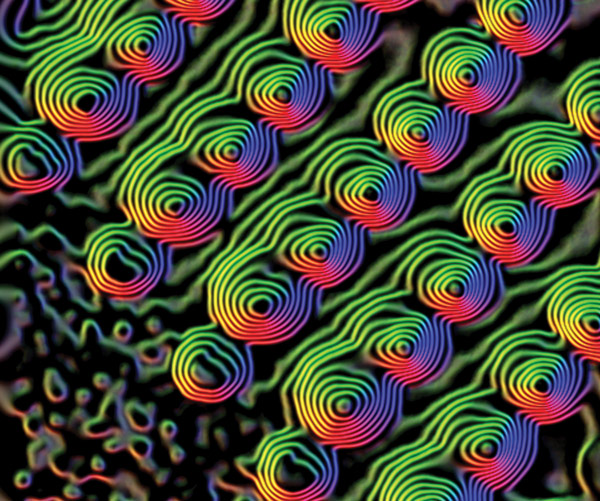Nov. 10, 2023 Research Highlight Physics / Astronomy
Dynamics of skyrmion spin states confirmed in neutron-scattering experiments
Neutron-scattering experiments confirm the dynamics of magnetic whirlpools, which could prove useful in future super-efficient devices
RIKEN researchers have brought low-energy devices based on spintronics one step closer, by measuring the dynamics of tiny magnetic vortices1.
At present, all our information technologies are based on conventional electronics, which involves shunting electric charge around circuits. However, electrons have another property known as spin, which could be exploited to make faster and more efficient devices.
Hazuki Kawano-Furukawa of the RIKEN Center for Emergent Matter Science and her co-workers are leading efforts to develop this field of spintronics. In particular, they are exploring the use of nanoscale magnetic whirlpools called skyrmions.
“Skyrmions can be controlled with significantly smaller currents or electric fields,” explains Kawano-Furukawa. “This makes them highly promising for future applications in information and communication technologies, such as computer memory that doesn’t need power to keep stored data.”
The team focused on the material manganese monosilicide—a helimagnet, so-called because the spins in its molecular lattice align in helical patterns. Extremely sensitive equipment was necessary to measure the lowest energy magnetic excitations in the skyrmion states.
“The only method that fulfills both the spatial and energy resolution requirements for this purpose is the neutron spin echo technique,” says Kawano-Furukawa. “We conducted experiments using the state-of-the-art IN15 neutron spin echo spectrometer at the Institut-Laue-Langevin in Grenoble, France. This instrument boasts the highest performance in the world for studying the dynamics of materials in magnetic fields.”

Figure 1: Spintronic materials that give rise to helical patterns of magnetic flux are promising for realizing devices with ultralow energy consumptions. © BROOKHAVEN NATIONAL LABORATORY/SCIENCE PHOTO LIBRARY
The spin echo method works by illuminating a sample with a beam of neutrons, and measuring how the sample’s magnetic fields affect the spin and velocity of the neutrons.
Through their observations, the team verified theoretical predictions that the string-like structures of skyrmions (Fig. 1) cause an asymmetric dispersion of excitations in the lattice of manganese monosilicide. In Kawano-Furukawa’s words, these excitations ‘know’ if they are traveling parallel or antiparallel to the cores of the skyrmion whirlpools. This confirmation of theory opens up the way to better exploit skyrmions.
The team had to wait two years to confirm their results. “We conducted our initial experiment in October 2018,” she says. “However, to draw final conclusions, we needed to confirm that the behavior was observed only in the skyrmion phase, and not in another magnetic structure called the conical phase. Due to the COVID-19 pandemic, the follow-up experiment was postponed to January 2021 and was carried out remotely, posing various challenges.”
The team now intends to conduct further research on how magnetic skyrmions are generated. “We aim to investigate the coexistence of the conical and skyrmion phases in manganese monosilicide,” says Kawano-Furukawa.
Related contents
- Scientists successfully manipulate a single skyrmion at room temperature
- An electrical change of phase using skyrmions
- Heat flow controls the movement of skyrmions in an insulating magnet
Rate this article
Reference
- 1. Soda, M., Forgan, E. M., Blackburn, E., Campillo, E., Ryukhtin, V., Hoffmann, I., Kikkawa, A., Taguchi, Y., Yoshizawa, H. & Kawano-Furukawa, H. Asymmetric slow dynamics of the skyrmion lattice in MnSi. Nature Physics 19, 1476–1481 (2023). doi: 10.1038/s41567-023-02120-5
